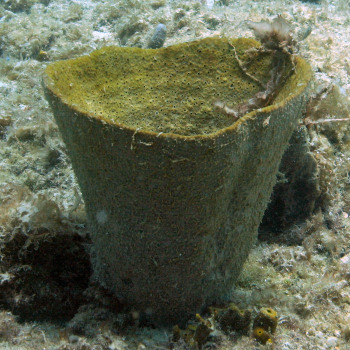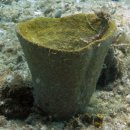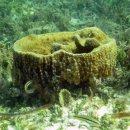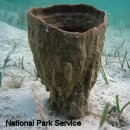| Common name(s): |
Vase sponge. |
| Growth form: |
Vase-, cup- or bowl-shaped, sometimes more or less cylindrical rather than widening upward; up to 60 cm tall and 40 cm across the top, and 0.5-3.0 cm thick. The sides of the cup may be of unequal heights. |
| Surface: |
Conules 2-8 mm high and up to 10 mm apart (usually 5-6 mm); those on the inner surface of the cup distinctly lower and more crowded. Sometimes appearing almost smooth; outer surface sometimes with weak to well-developed vertical ribs or ridges. |
| Color: |
Brown, greenish-brown, reddish-brown. |
| Consistency: |
Rubbery, difficult to cut. |
| Exudate: |
None. |
| Oscules: |
Small (4-10 mm across), irregularly scattered on inner surface of cup only. The large opening at the top of the vase or cup is not itself an oscule. |
| Skeletal Components (Spicules, Fibers): |
Irregular fiber meshwork sparsely cored with sand and foreign spicule fragments (300-700 μm wide). Connecting fibers 30-150 μm across. Thin spongin filaments (3-6 μm wide) with knobbed heads (9-10 μm wide) fill in between fibers. No native spicules; any spicules in fibers are foreign. |
| Skeletal Architecture: |
No exterior skeletal specialization, but foreign material forms a reticulation on the surface leaving pores 250-500 μm across. Interior fibers arranged in ascending bundles (fibrofascicles) that diverge radially from the inner to the outer cup wall (200-770 μm wide), connected by narrower fibers. |
| Ecology: |
Common on shallow hardgrounds, seagrass beds and inshore reefs in as little as 1 m. |
| Distribution: |
From North Carolina and Gulf of Mexico throughout the Caribbean to Brazil; also in the Mediterranean Sea. |
| Notes: |
Specimens fit well with literature descriptions. |
| References: |
van Soest (1978), Zea (1987). |
|
|
| Similar species: |
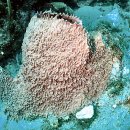
Xestospongia muta |
|
